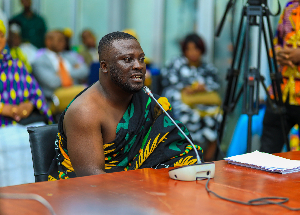Clothing, though often seen as a necessity, carry profound symbolic significance that transcend their functional purposes.
Across cultures and traditions, they serve as a medium to communicate identity, values, and heritage.
Traditional garments often reflect the values and identities of communities.
This symbolism was demonstrated by the Ashanti Regional Minister-designate, Dr. Frank Amoakohene, during his vetting by the Appointments Committee of Parliament on Monday, January 27, 2025.
Responding to questions on his attire for the vetting, by the Member of Parliament of Weija Gbawe, Ahmed Shaib, Dr. Amoakohene shed light on the cultural importance of his kente cloth, named Asanteman, chosen for its symbolic connection to the Ashanti Kingdom.
“I chose this cloth because of its name and its cultural significance. The name of the cloth is Asanteman, and if you look closely, embroidered in it is the porcupine, which is the symbol of Asanteman,” he explained.
Delving into the symbolism of the porcupine, Dr. Amoakohene noted, “The porcupine is a very tactful animal, always on alert for self-defense and employing well-coordinated strategies to survive in any situation. It has quills or spines, which, although they appear individually positioned on the back of the porcupine, work together in a very coordinated manner. These quills either protect the animal from predators or assist it when it needs to undertake a specific activity. The porcupine symbolises the unity, resilience, and strategic collaboration of the Asante people.”
The cloth also featured another significant element – the spider web, deeply rooted in Ashanti oral tradition.
“The cloth also includes a spider web. In Ashanti tradition, we use Kwaku Ananse in many of our folktales. The spider web signifies wisdom, interconnectivity, and oneness within the Ashanti Kingdom. It reflects the interconnected nature of our traditions and values,” Dr. Amoakohene stated.
Beyond these, the cloth bore symbols of the akofena (ceremonial swords) and a gun, which, according to Dr. Amoakohene, represent “royal authority and loyalty to Asanteman and the Republic of Ghana.”
He also elaborated on the colours of the cloth, explaining their significance.
“The colours were carefully chosen. The green represents the forest and the greenness of the Asante Kingdom. The yellow signifies the richness of the Ashanti Kingdom, and the black represents our race and the collective strength of the Asante people. It also reflects the unity of the Black race that brought together the Ashanti people under the leadership of His Royal Majesty,” he remarked.
The Ashanti Regional Minister-designate also offered a glimpse into the profound ways the kente cloth can serve as a canvas to honour and preserve cultural identity.
“Every element of this cloth reflects the enduring pride, unity, and cultural heritage of Asanteman,” he added.
Watch the video below:
Ashanti Regional Minister-designate @DrAmoakohene explains the meaning of his Kente cloth #JoyNews pic.twitter.com/JR13tfo9o8
— JoyNews (@JoyNewsOnTV) January 27, 2025
JKB/AE
Meanwhile, meet the university graduate helping to prevent accidents in Ghana



